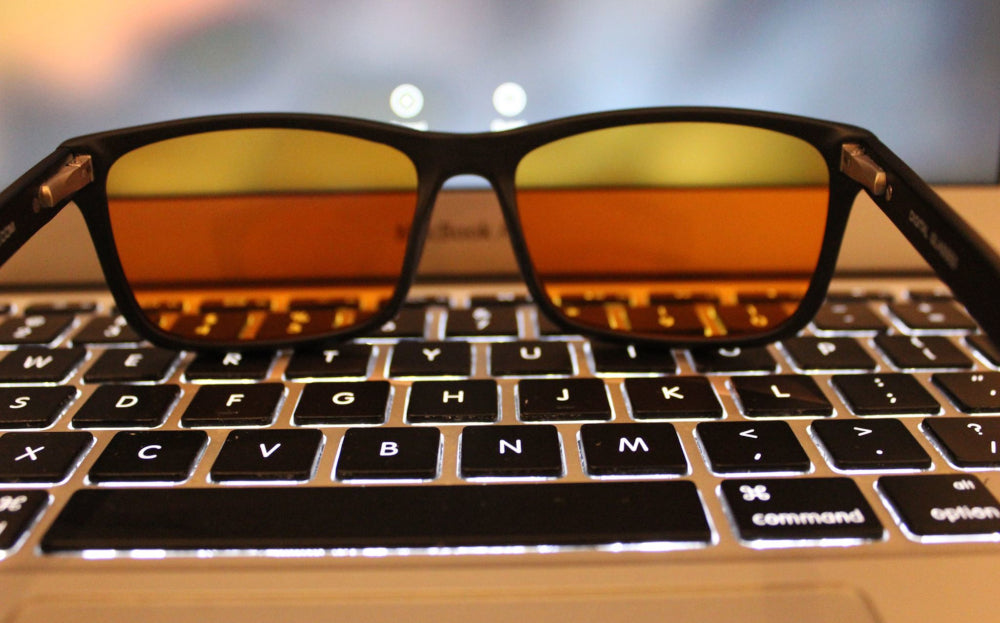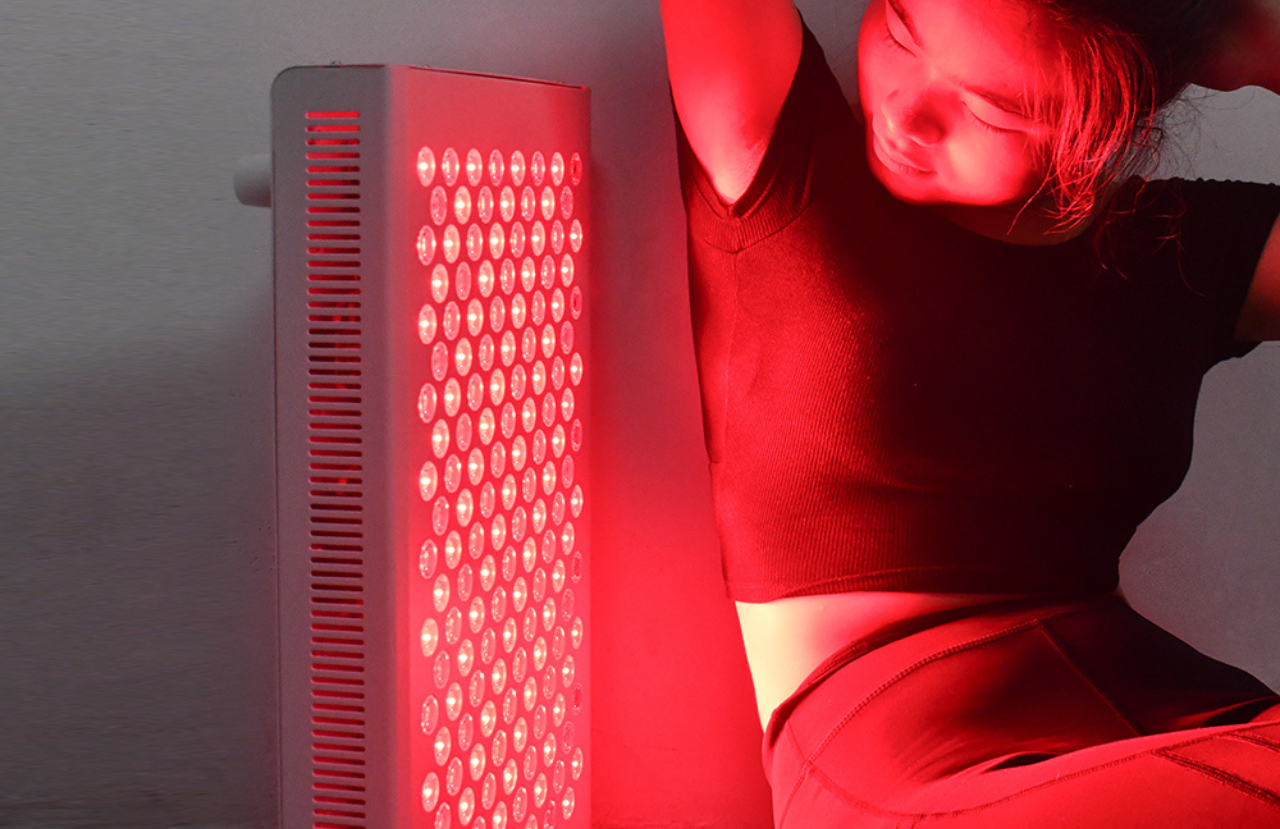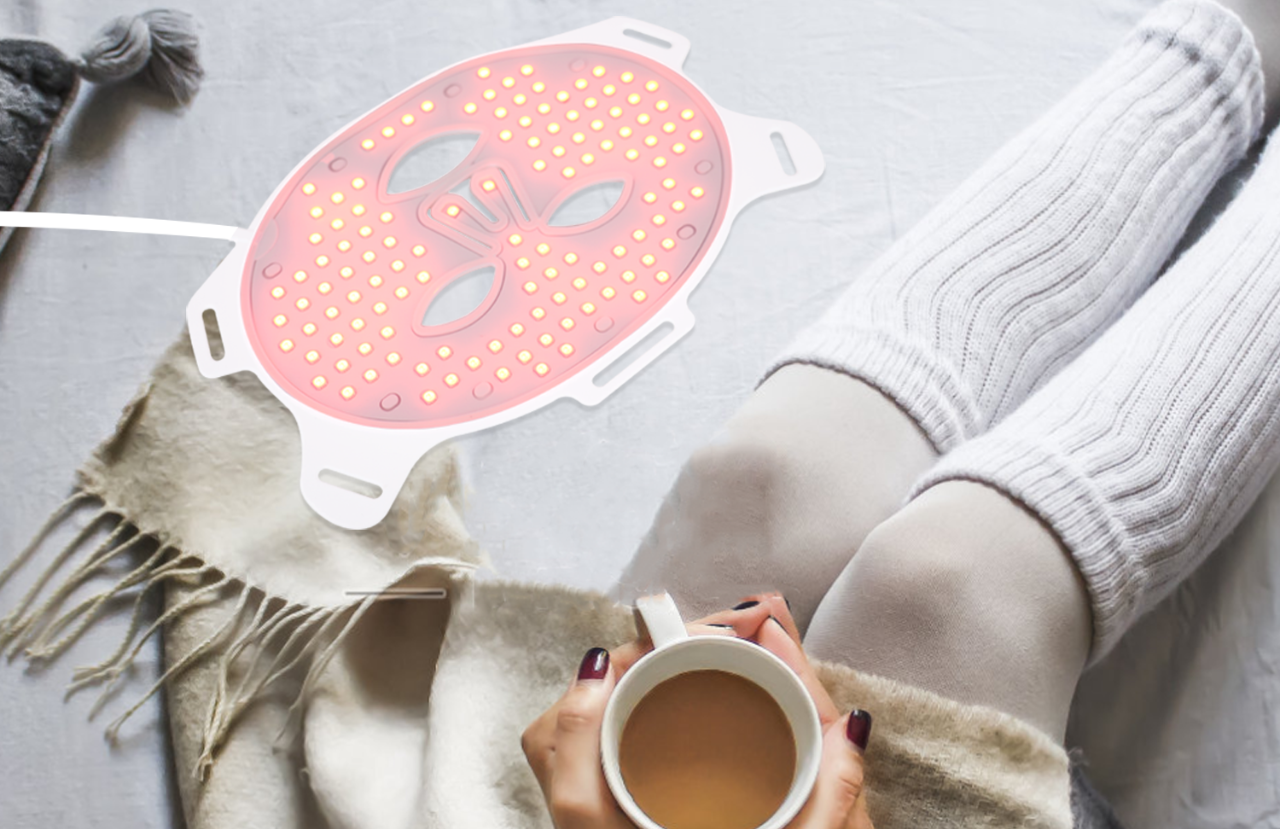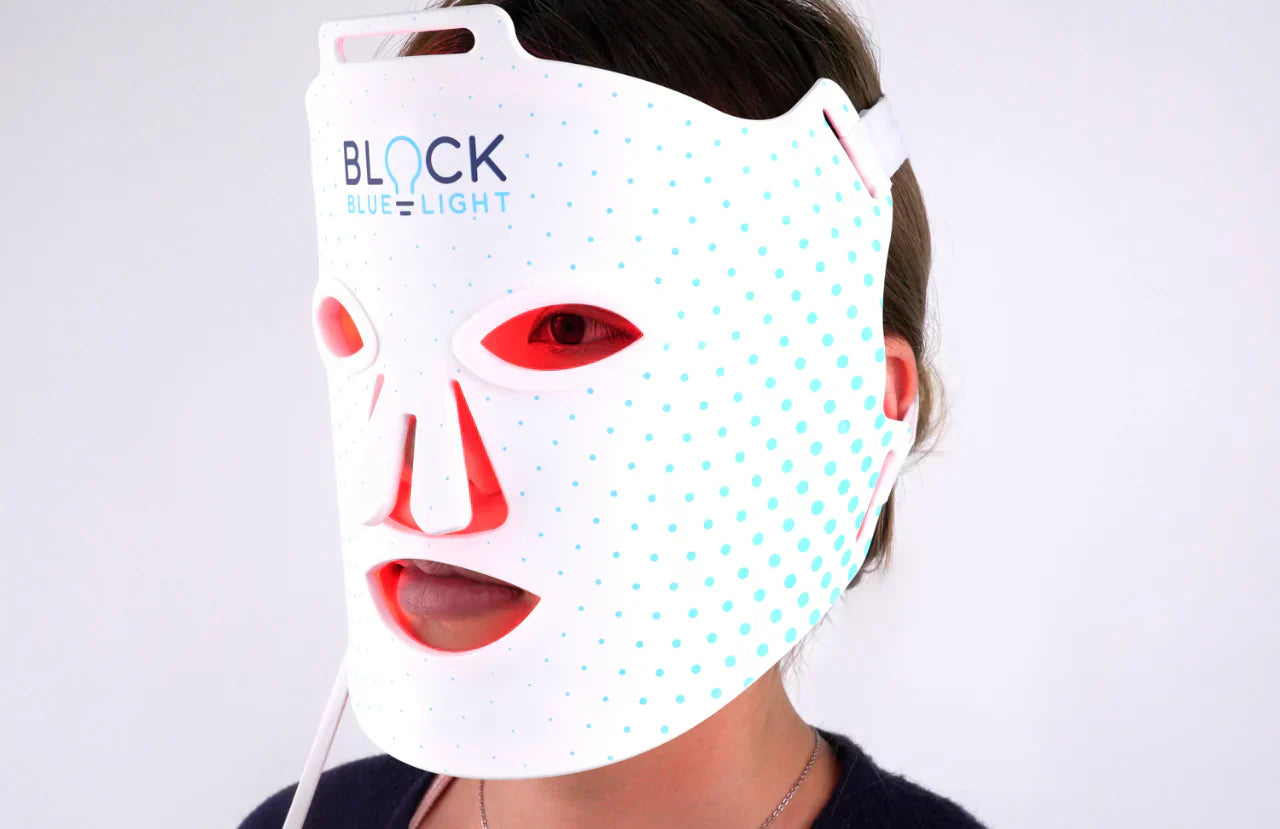Jump To Section
- Why should anyone test anti blue light glasses?
- The most accurate blue light glasses test
- How to test anti blue light glasses for daytime (Clear lens)
- The best blue light glasses tests for night-time (Amber and red lenses)
If you’re curious about testing your blue light glasses to see if your pair is legitimate, you’re on the right track. Different pairs of blue light glasses block different wavelengths of the light spectrum, and in varying quantities.
In this article we will cover the different methods of doing blue light glasses tests at home for the following:
- Daytime glasses with clear lenses
- Night-time glasses with red or amber lenses
- We’ll also cover the test you want to avoid at all costs!
Continue reading to find out about the different blue light lens tests for each type of glasses and to answer any concerns that you might have about their use.
Why should anyone test anti blue light glasses?
Science has established the harm that prolonged exposure to blue light causes to your vision. Unfortunately, it is unavoidable at this point- we’ve tried all the hacks to reduce screen time and there’s a limit to which they work. All the electronics around us have become an unavoidable part of our lives and they ALL emit blue light.
Thanks to science, the solution to this one exists: blue light glasses aligned with science. They are equipped with lenses specifically designed to filter the intake of blue light. They filter out the excessive rays from artificial sources and protect our eyes.
Nonetheless, skepticism is bound to exist with any product like this, and rightly so.
Customers often ask whether this is another scientific gimmick or whether blue light glasses actually do what they claim to do. This is an important question because Not all Blue Light Blocking Glasses Are Created Equal and most glasses available in the market, which claim to ‘filter blue light,’ have no information available on the amount of blue light filtered or which exact wavelengths are being filtered. On top of that, they’re not aligned with the science of filtering light, to work with your body and mimic natural conditions.
Continue reading to find out about the science behind blue light glasses, and how to test them. Once you test your anti-blue light glasses, you’ll be sure that you are getting a product that works and are not being scammed by an ineffective pair.
The most accurate blue light glasses test
The best way to know whether your blue light glasses work or not is to use a spectrometer.
This is a lab instrument that splits visible light into its colored wavelengths. The lens of the glasses is then placed in the device, and a detector determines what part of a specific wavelength is passing by or getting blocked by it.
Since this is professional-grade lab equipment, the results you get are highly accurate and this is the gold standard for testing blue light glasses. The catch, however, is that it's an extremely expensive instrument that will not be available to the general public. You won’t find this at an optics store or your eye doctor’s office and it will only be available in highly specialized optics laboratories.

BlockBlueLight owns a lab-grade spectrometer, we use this to verify all our lenses, and the results are published on our website, along with each glasses option. If the company you are looking at buying from doesn’t publish have a lens testing report generated from a lab-grade spectrometer then this is a big red flag; they either have something to hide or simply don’t know which wavelengths are being filtered by their glasses.
Because spectrometers are extremely expensive and hard to come by, (and it makes no sense to buy a device that costs more than a pair of glasses!) there are some other basic methods you can use to test your blue light glasses at home to get an idea if they are legitimate.
However, if you do come across this machine by any stroke of luck, then definitely check your glasses to get an accurate answer.
We will cover some ways you can perform a blue light lens test at home without the spectrometer.
How to test anti blue light glasses for daytime (Clear lens)
It is important to note here that clear lens glasses are meant to be worn during the day; for nighttime, red or amber-tinted glasses are essential.
Clear lens glasses, such as our daytime range do not block out blue light entirely - their technology is based on filtering out the excessive rays that are harmful to the eyes and protecting them from eye strain, while still allowing the beneficial blue light through that’s responsible for mood, and feeling awake and alert.
Pro tip: When buying blue light glasses for the daytime, pick a pair that filters blue light by 50% of light at 455nm, this is the exact wavelength emitted from screens and lighting. This means that the eyes are protected from the peak wavelength where most of the damage occurs.
1. Transmittance Spectrum Report
This is the first step and crucial too. Before you decide on purchasing a specific pair of glasses, ask the brand for the Transmittance Spectrum Report.
This detailed report will reveal how much blue light is filtered out from the glasses. It is vital to fact-check rather than just believing in word of mouth!
If any company fails to provide you with this simple report, they are not to be trusted.
How to read a transmittance spectrum report:
Focus on the percentage of blue light that the report mentions. Your glasses need to filter out the harmful rays while ensuring that they do not block them out entirely because that would make the screens hard to view and impact your energy levels.
Reading a transmittance report for clear lenses:
A safe percentage is 50%. Your daytime glasses must filter out at least 50% of all blue light across the spectrum for them to be user-friendly and helpful. Anything less than this is better left un-bought because it is not going to be of any use.
Our daytime range of glasses filters a whopping 50% of blue light across the entire blue light spectrum. This is what sets our glasses apart from cheaper alternatives that filter 10 or 20 percent of the light and won’t show significant results.
The exact wavelengths of the filtered blue light also matter, and you must look at this detail in the report as well. The most harmful blue light from our devices is in the 455nm part of the spectrum so ensuring the glasses as actually filtering down a significant amount of the 455nm is very important. A detailed lens testing report will show a breakdown of all the different wavelengths along the blue light spectrum and show what percentage of light is being filtered at each range.
Remember: Don’t take the company’s word for the specifications. Ask for the report as proof. A reliable company won’t hesitate to provide you with the detailed report.
The following test is from BlockBlueLight’s screentime range of glasses using a spectrometer:

2. Reflection Test
An easy test you can do at home to get an idea of whether your blue light glasses are actually filtering blue light (and not green and violet light) is the reflection test.
This is not the most accurate way to test anti-blue light glasses, but they will give you an indication if any or some blue light is being filtered.
You can start by noticing the reflection that is reflected off the lens of your glasses once you wear them. If it is the reflection colour is blue, then that means your glasses are reflecting some amount of blue light. If not, then they are probably not useful.
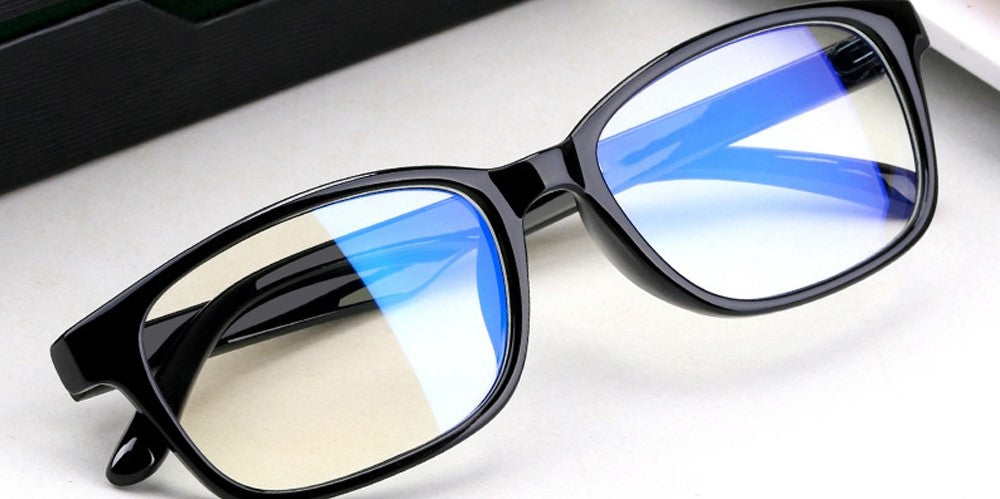
Many of the popular brand’s blue light computer glasses are reflecting violet or green light which would indicate they won’t be very effective.
Green coatings are commonly used as an anti-glare coating but isn’t designed to filter blue light.
Be careful not to fall into marketing tactics of companies whose products reflect violet light and claim protection against UV light. That is not present in your LED screens or lighting, so it is just a marketing gimmick.
3. Pigments test
The next blue light glasses test you can do for clear lens daytime glasses is the lens pigment test.
This can be performed by holding your glasses up to your eyes and looking at something that is a bright white colour such as a piece of paper or a white background on a screen.
If white colours warm-up very slightly, this indicates there are special pigments inside the clear lens designed to absorb blue light as it passes through the lens.

If the lens is 100% clear and the white colours do not warm up at all, this indicates the glasses only have a basic anti-reflective coating which can only filter approx. 5 - 20% of blue light max.
Using special blue light-absorbing pigments inside the lens combined with the reflective coating allows the lens to filter 50% of blue light if its done right.
4. Blue light pen test (Don’t waste time with this!)
There are certain home tests that you can find online but are inaccurate and a complete waste of time. One of them is the blue light pen test. This pen does not tell whether blue light glasses work at all and it’s a scam method used by cheap sellers to convince buyers that their product works.
What is the blue light pen test?
The blue light pen test comes with blue light glasses imported from China, although some local manufacturers have started to include it in their boxes it too. The test includes;
- A blue light pen, and;
- A little white card.
The instructions say the pen emits blue light. For proof, you can shine the light on the card and you’ll see it appear blue. To test whether the glasses filter blue light, you shine the pen through the lens of your glasses and you’ll see the rays being filtered and not passing through.

However, this test is fake.
First of all, the pen does not emit blue light, but violet light. The wavelength of violet light is from 380-400 nm. When you shine the light on the card or any white surface, you’ll see a purplish tinge to it. We’ve tested many of these pens using lab-grade spectrometers and their range does not even come near to the wavelengths of blue light (400-500nm).
Secondly, the light emitted by screens and LEDs is blue, not violet light and it ranges from 400nm to 500nm. It’s blue light (from artificial sources) that is responsible for disruption of circadian rhythm, digital eye strain, and vision problems, not violet light.
Thus glasses which pass the pen test filter violet light and do not help with damage from blue light emitted by screens and LEDs.
If any company includes the blue light test or endorses it on their site, they either don’t know what they’re doing, or more likely, they are scamming people. Resort to asking sellers for a spectral test report if you want proof that the glasses are legitimate.
The best blue light glasses tests for night-time (Amber and red lenses)
Clear lenses are only designed to use during the daytime. Exposure to blue light in the evening or at night affects the quality and amount of sleep that we get.
For nighttime, you require either;
- Red lenses that block 100% of the blue light and green light up to 550nm, or;
- Lighter amber lenses that block 100% of blue light.
This is because after the sunset, you’re not supposed to be exposed to any amount of blue light.
Our NightFall range blocks out 100% of both blue and green light up to 550nm and helps achieve optimal sleep.
By using two different glasses for day and night-time, your body can receive natural amounts of blue light and follow its natural circadian rhythm.
Here are some blue light lens tests you can use to evaluate the quality of these night-time amber/red lenses too.
1. Transmittance spectrum report
The foolproof way to know whether your night-time glasses work is from the transmittance spectrum report. Ask the company you’re buying from for this as proof and make sure that the test you are receiving is from a lab-grade spectrometer.
If the lens is amber it should block 100% of the blue light, if the lens is red it should block 100% of blue and green light up to 550nm. Anything less than this will not make for functional night-time glasses and will not provide you with the best quality of sleep. This is because the slightest exposure to blue light sends signals to the brain that it is daytime.
The following test is from BlockBlueLight’s nightfall range of glasses using a spectrometer:

2. The Squares Test
In this test, you wear your blue light glasses and look at blue and black squares. If they both appear black, then your glasses block the blue light completely. If not, then you should probably get rid of them and look for a pair that works.
Steps:
- Look at the squares below. They are black and blue respectively.
- Put on your red/amber lens blue light glasses (the ones you wear after sunset)
- If your glasses are blocking blue light completely, both squares will appear black or very dark grey.

3. The RGB Chart test
Another thing you can do is look at an RGB color chart with your blue light glasses and see if the blue area is completely blocked off.
This will not work with daytime glasses as they do not block off all blue light. So this test is not an effective measure to test daytime blue light glasses, but it will give a good idea of the effectiveness of night-time sleep glasses.
Steps:
- Take a look at the RGB circle test chart below.
- Put on your red/amber lens blue light glasses (the ones you wear after sunset)
- The blue section B will appear black, if wearing a red lens, the green section G should darken considerably.
- The dimming of the green circle shows that your glasses are filtering some amount of green light, which has also been shown to disrupt melatonin levels. (Please note with the lighter amber lens they will not alter the colour of the green circle as they are only designed to block blue light and not green)

These last two home tests are a great way to do some basic blue light glasses tests, but they don’t give you 100% accurate answers. Use them as a good initial test, but always the best and safest way is to obtain a test report from a company with access to a lab-grade spectrometer. That’s the gold standard to test blue light glasses effectively and accurately.
Conclusion
In a nutshell, before you settle on a pair, it is essential to test anti-blue light glasses. If you already own a pair, it’s a smart move to test it out, to see if you’re getting any benefit from putting in so much effort. There are many blue light tests for this purpose, which have all been summarized in the article above.
Some of them have more weight than others; however, any of these will work in getting a basic idea of whether the product is worth investing in or not.
Our daytime as well as nightfall glasses stay true to their claims and show up in all of these tests. We would advise you to keep all of the above points in mind before you make any purchase so your eyes and health remain safe.
References:
Blue light has a dark side. Harvard Health. (2020, July 7). https://www.health.harvard.edu/staying-healthy/blue-light-has-a-dark-side.
Protect your vision. Blue Light Exposed. (n.d.). http://www.bluelightexposed.com/protect-our-vision/#how-can-you-protect-your-vision-against-the-harmful-effects-of-blue-light-exposure.
Team, A. A. V. E. (2021, June 14). Blue light glasses test: How well do your blue light glasses work? All About Vision. https://www.allaboutvision.com/eyeglasses/test-blue-light-glasses/.
Team, A. A. V. E. (2021, June 25). How blue light is both bad for you AND good for you! (Huh?). All About Vision. https://www.allaboutvision.com/cvs/blue-light.htm.

